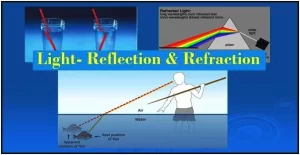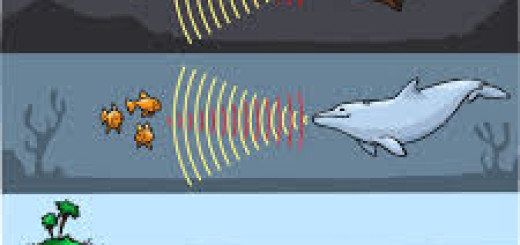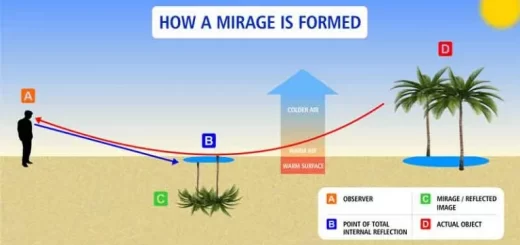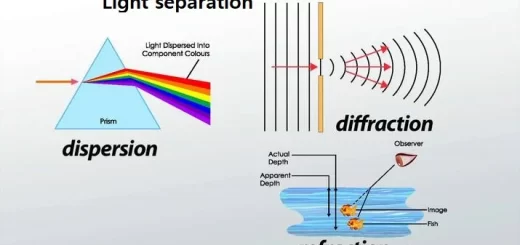What are the causes and uses of the light refraction?
The refraction of light occurs when the light passes across the boundary between two media, It is the change of light path when it travels from a transparent medium to another transparent medium of different optical density.
What is light refraction?
Light refraction is the bending of light as it passes from one medium to another with a different optical density. This occurs because light changes speed when it moves between materials with different refractive indices.
The transmission of light across a boundary between two media is accompanied by a change in both the speed and wavelength of the wave, and the light wave will not only change its direction at the boundary, but it will change its speed and wavelength.
The ability of the transparent medium to refract the light is called the optical density of the medium, and it is the ability of the transparent medium to refract the light, and when the optical density of the medium increases, the speed of light through it decreases and vice versa.
The light will not refract when the light wave passes through the boundary in a perpendicular direction, and each medium has its own optical density, so, the optical density of a medium differs from one medium to another due to change in the light velocity through such medium.
Light slows down in denser mediums (e.g., from air to water) and speeds up in less dense mediums (e.g., from water to air). If light enters a new medium at an angle, it bends toward the normal (if slowing down) or away from the normal (if speeding up). Snell’s Law: The relationship between the angles of incidence and refraction is given by:
n1sinθ1 = n2sinθ2 , where n1 and n2 are the refractive indices of the two media.
Total Internal Reflection – If light moves from a denser to a less dense medium at a high enough angle, it reflects instead of refracting.
Light refraction uses
The light refraction can be used in the clinical significance in medicine especially in optometry, ophthalmology and orthoptics, the refraction is also known as the refractometry which is used to determine the eye’s refractive error and the best corrective lenses to be prescribed.
There are a series of test lenses in graded optical powers or focal lengths are presented to determine which provides the sharpest and the clearest vision, and the cornea, the aqueous humor, the lens, and the vitreous humor are refractive media.
The refraction of light occurs when the light passes from the air to the cornea in the eye, from the cornea to the aqueous humor, from the aqueous humor to the lens and from the lens to the vitreous humor, and the light wave spreading out from one point on an object can, therefore, be focused on a particular point on the retina.
The images are formed in a camera by refraction in a manner similar to the image formation in the eye, So the accommodation to image closer objects is done differently in the eye and the camera.
The lens can focus the light, and it can produce converging or diverging light rays due to the refraction. and there are two types of lenses which are the convex lenses which cause the parallel light rays to converge, and concave lenses which cause parallel light rays to diverge.
The convex lenses can allow the magnification, and the light reflecting off an object is focused to a point, and you should know that a magnifying glass is one the convex lens that allows the magnification of objects.
The microscope is basically a series of lenses that take advantage of the nature of refraction of light due to the nature of light, The maximum amount of refraction that can be possible by material, there are limits to the amount of magnification that can be done by a light microscope.
Some media have an index of refraction that varies gradually with the position, So, the light rays curve through the medium rather than travelling in straight lines, So, the mirages can be seen on hot days where changing the index of refraction of the air causes the light rays to bend creating the appearance of specular reflections in the distance (as if on the surface of a pool of water).
Examples of Refraction in Daily Life
- A straw appearing bent in a glass of water.
- The apparent shallowness of a swimming pool.
- The formation of rainbows is due to light refracting in water droplets.
- Lenses in glasses and cameras focus light by refraction.
You can subscribe to Science Online on YouTube from this link: Science Online
Types & Laws of light reflection, Regular & Irregular reflection of light
Applications on the total reflection of light (Optical fibers, Reflecting prism & Mirage)
Light refraction effects, Law of light refraction, Mirage & Apparent positions of objects
Light refraction, Snell’s law, Factors affect the absolute refractive index of a medium
Properties of the formed images by convex lens and concave lens




